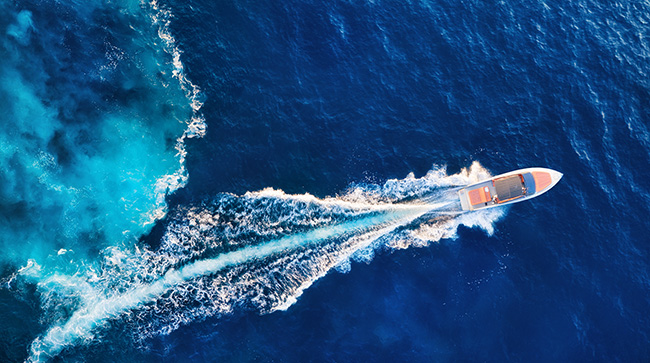Measuring and monitoring human activity at sea is critical for a variety of reasons: national defense and security, resource management and environmental monitoring are just a few areas that rely on this. However, the ability to effectively detect vessels in expansive ocean settings remains challenging, even with tried-and-true technology like sonar and radar.
This challenge is further compounded by the fact that potential threats and bad actors deliberately maintain a low profile at sea, skirting international maritime laws and radio/cell transmission to avoid detection.
To combat this, scientists at The Aerospace Corporation are working on a new alternative that analyzes something that all sea-faring vessels leave upon the water: Kelvin wakes. These ephemeral V-shaped impressions that trail vessels as they move are typically 38 degrees across, with wave characteristics influenced by the speed of the vessel itself.
Aerospace’s scientists have determined that a wake’s alteration of the structure and temperature of surface water can be linked to specific types of vessels, providing a means of indirectly resolving vessels at sea where sonar and radar cannot.
The project, known as Wake Infrared Night/Day Sensing (WINDS) utilizes a polarized longwave infrared (LWIR) sensor to detect wakes. For the uninitiated, LWIR is a subset of the infrared band of the electromagnetic spectrum that enables radiating heat to be visible to a thermal imaging camera. Furthermore, polarimetric signatures highlight subtle spatial structures, providing an additional level of imaging insight.
“We’ve found that polarized light can resolve wakes and waves and analyzing their patterns can tell us how fast a vessel is traveling and where it’s headed,” said Dr. John A. Hackwell, a Technical Fellow at Aerospace. “Another benefit of using infrared is that it allows for day and night imaging, and the sensors can be placed on any aircraft.”

Last year, the WINDS prototype was integrated onto an Aerospace flight test gimbal on a Twin Otter aircraft and performed its first flight test, during which it looked for boat wakes in both day and night scenarios. This initial pathfinder project went from concept to flight in six months and now has the critical data needed to evaluate phenomenology for this type of application. “We now have the capability to geo-reference images to locate vessels, and to couple our sensor with another spectrometer (MAHI) that can detect carbon monoxide and other exhaust fumes emanating from vessels at sea,” said Hackwell.
Radar and sonar remain indispensable tools for exploring and mapping the ocean. Whereas radar employs reflected pulses of high-frequency electromagnetic waves to detect the presence, direction, distance, and speed of objects, sonar employs reflected pulses of sound to accomplish the same task.
Unfortunately, these traditional methods of surveying the ocean are not effective when tasked with detecting objects on the ocean’s surface. Radar is ill-suited for discerning boats and other sea-faring vessels against a backdrop of maritime “noise,” and because sound waves travel further in water than radar and light, NOAA scientists have primarily used sonar to develop nautical charts, detect underwater hazards to navigation, search for objects on the seafloor, and map the seafloor itself.
The nascent WINDS technology may be applicable to Navy, Coast Guard and Department of Homeland Security (DHS) applications in the never-ending fight against drug smuggling and human trafficking at home and abroad. Preliminary tests have proven that the technology works, and expanded testing will determine its large-scale practicality. As always, Aerospace’s ability to rapidly test new concepts has proven to be a critical element in quickly evaluating this new technology.
“We’re showing a close correlation between experimental data and simulated results of various velocities,” said Hackwell. “Ultimately, WINDS technology may end up being as useful to our national security as radar and sonar have been, and a valuable tool in our defense arsenal.”

